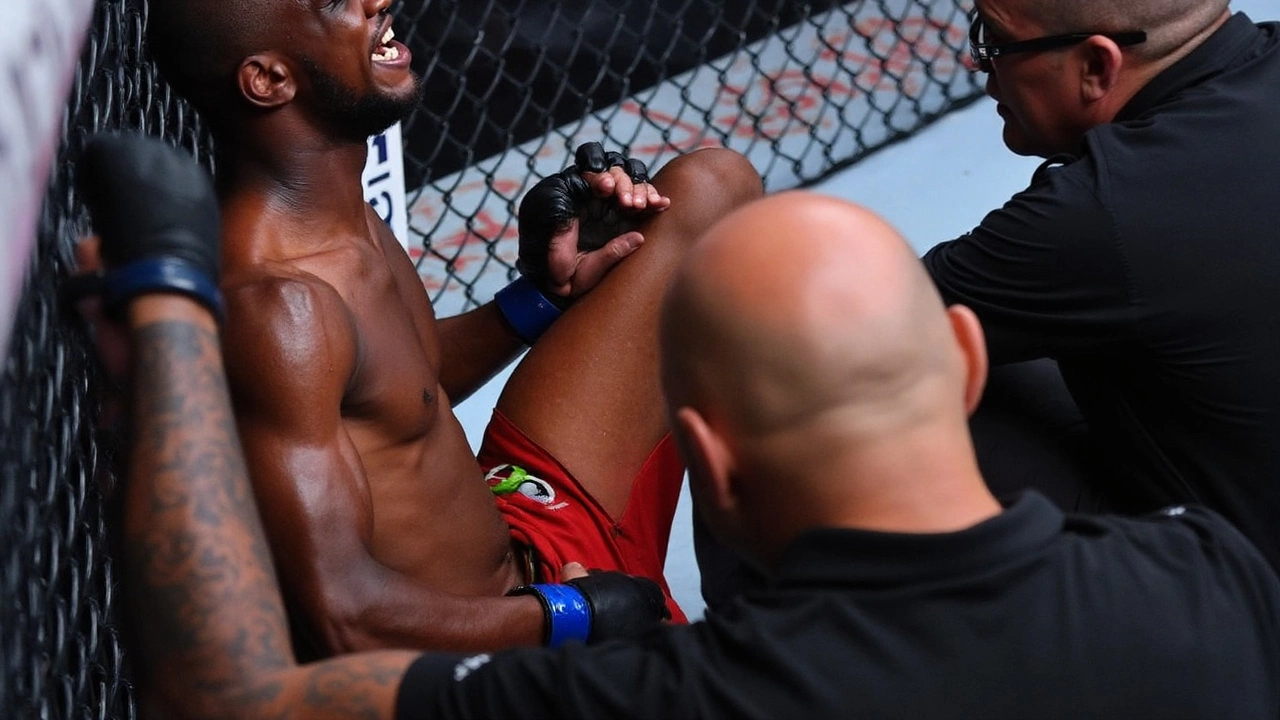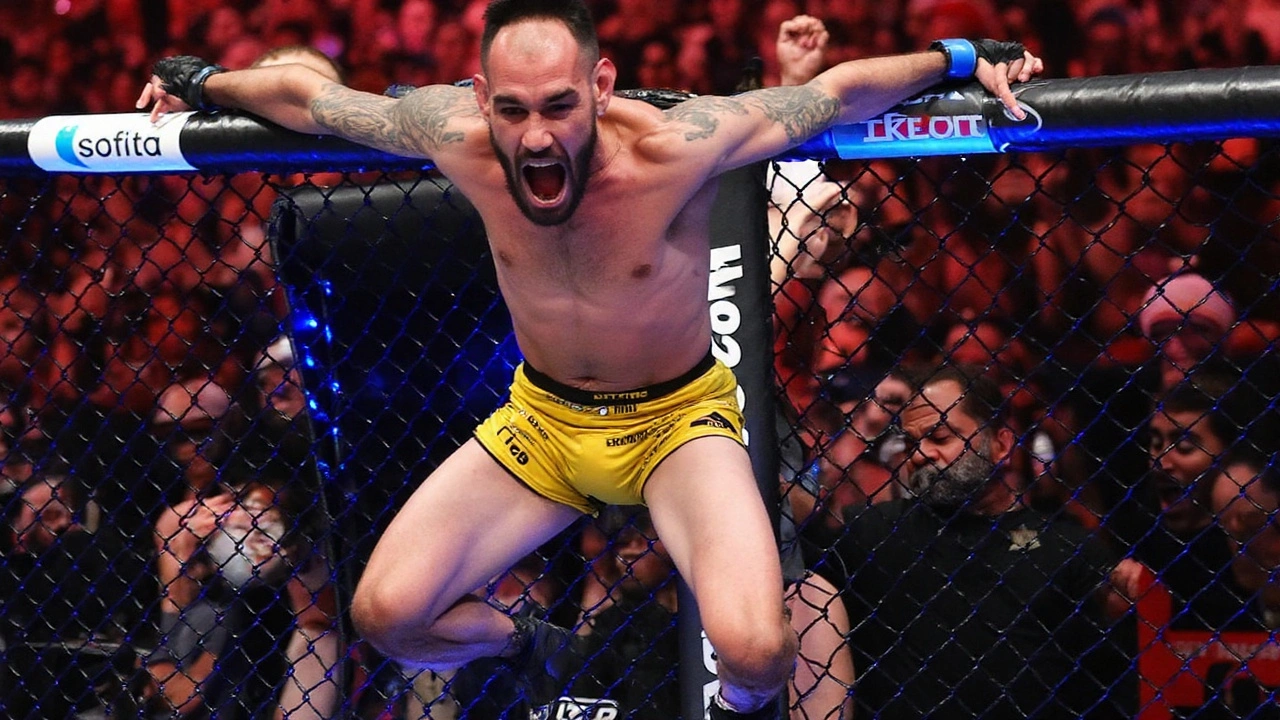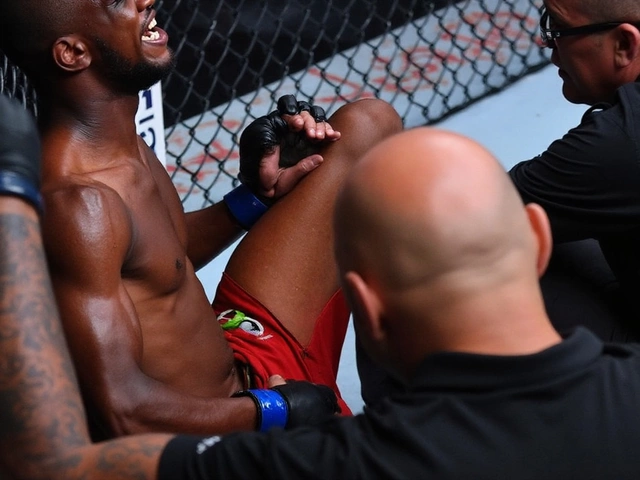UFC Fight Night 259: Accidental groin kick ends Reese vs. Dumas in 51 seconds

- Kieran Winchester
- 14 September 2025
- 0 Comments
By Kieran
The middleweight meeting between Zachary Reese and Sedriques Dumas ended almost as soon as it began, stopped after an accidental groin kick just 51 seconds into Round 1 at the Frost Bank Center in San Antonio. The kick landed clean on the cup and echoed in the arena, drawing an immediate groan from the crowd as Dumas crumpled to the canvas. Doctors rushed in, Dumas stayed down, and after a brief but tense evaluation, the referee waved it off and recorded a no contest. It was a jarring turn for a matchup that had real momentum behind it going in to UFC Fight Night 259.
What happened inside the cage
The opening told you this could have been a fun fight. Dumas, 10-3 (3-3 UFC), started fast, snapping a double jab into a straight right and taking the center. Reese, 9-2 (3-2 UFC), answered with low kicks from the opposite stance, setting a range battle that was going to come down to timing on the entries and who won the kicking lanes.
Then it unraveled. As the two traded kicks, Reese threw a low shot that strayed off target and smashed flush into Dumas’s groin. The sound carried, the replay drew a collective wince, and Dumas immediately grabbed the area and fell. Referee intervention was instant. The cageside physician came in while the clock was paused, as the rules allow.
On the canvas, Dumas could be heard telling the doctor, “I can’t feel my right ball,” a raw line that said more than any slow-motion replay could. Under the unified rules, fighters are allowed up to five minutes to recover from a groin strike. Dumas tried to breathe through it. Officials checked his responsiveness. He attempted to shift his position but remained in clear agony. About two minutes into the window, he told the officials he couldn’t continue.
Reese’s face said it all—frustration, then remorse. He walked over and apologized to his opponent as the referee called it. The bout was ruled a no contest due to an accidental foul at 0:51 of Round 1. No points, no controversy about intent—just an unfortunate end that left both men with the same record they walked in with and no answers about who would have solved the other first.
That matters for both. Reese has been trying to build consistency at middleweight after a stop-and-start run in the UFC. Dumas, who had sharpened his jab and looked set to test Reese’s defense, needed rounds to show he’s turned a corner against physical kickers. Instead, they leave San Antonio with a result that clarifies nothing and a highlight nobody wants replayed.

The rules, the gear, and the debate after San Antonio
This kind of ending always sparks the same question: is there a better way to handle accidental fouls? The unified rules give fighters up to five minutes after a groin strike. If the injured fighter can’t continue and the stoppage happens before the halfway mark of a three-round fight, the result is a no contest. If an accidental foul forces a stoppage after that threshold, judges can go to the scorecards for a technical decision. In San Antonio, the kick came less than a minute into Round 1—well before any scoring cushion existed.
There’s a clean separation between accidental and intentional. If a referee determines the foul was on purpose, it’s a disqualification or, depending on circumstances, a TKO for the fouled fighter. For accidental fouls, referees can issue warnings or deduct points if the bout continues and the strikes are repetitive, but the first job is to protect the hurt athlete. Saturday night, the call was straightforward: clear accidental foul, visible functional impairment, and not enough time for a safe recovery.
Some of the risk is baked into how MMA is fought. Low kicks at close range are fast, and when fighters are in opposite stances—as Reese and Dumas were—the inside leg is often the target. Miss by an inch, and the shin or instep slides up into the cup. It doesn’t take much speed for that to do real damage, even through protective gear.
About that gear. Men are required to wear a groin protector approved by the commission, usually a hard-shell cup secured by compression shorts or a jock system. The good ones stop catastrophic injury, but they don’t erase pain, nerve shock, or the nausea that follows a direct hit. That’s why the five-minute window exists. It’s also why five minutes sometimes isn’t enough. Nerve stingers can linger. Muscular spasms make standing a challenge. For Dumas, it wasn’t a matter of toughness; it was physiology.
Fans and fighters go back and forth on fixes. Some argue for longer recovery time, especially in the first round, to avoid fights ending before they start. Others caution that extended breaks change the rhythm of a bout and can reward fouls, even unintentional ones. There are calls for stricter point deductions to discourage sloppy targeting, but docking a point 50 seconds into a fight that never resumes just shifts the frustration—it doesn’t solve the stoppage.
Video review is another piece. Commissions increasingly allow referees to use replay to determine what happened, who was fouled, and whether the strike was legal or not. In this case, there wasn’t any ambiguity. The replay made everyone wince, and the audio told its own story. When the evidence is that clear, process is the easy part. The hard part is living with an unsatisfying result.
What comes next is pretty predictable. Expect a short medical suspension for Dumas while he’s evaluated and cleared—standard practice after a fight-ending foul. He’ll likely undergo imaging to rule out anything more serious than trauma. Reese will want to get rebooked quickly, but the cleanest option is to run this one back once Dumas is cleared. Matchmakers often try to repair nights like this with a rematch, especially when neither man got the chance to show his work.
There’s also the career math. A no contest doesn’t move the ranking needle. It doesn’t teach the brass much about ceiling and floor for either man. Reese loses the chance to prove he can manage an aggressive jabber early. Dumas loses the chance to test-drive his pressure against a kicker who can change levels in the pocket. Both lose valuable cage time—film for coaches, reps for timing, the stuff that turns mid-carders into contenders.
Inside the arena, the response had two beats. First, the hush and the groan after the replay. Then an uneasy applause for sportsmanship as Reese apologized and Dumas received care. That mix—shock, sympathy, and a collective shrug at the anticlimax—is familiar in a sport where the line between perfect technique and a foul can be a half-inch of drift.
There isn’t a neat fix. Better cups help, but they’re not painkillers. Longer breaks solve some situations and create others. Harsher penalties curb sloppiness but can’t erase accidents. The rulebook’s compromise—time to recover, clear thresholds for results, and deference to fighter safety—handled San Antonio by the book. Nobody leaves happy, but everybody leaves intact enough to fight again, which is the point.
For Reese and Dumas, the only good outcome now is another booking and a clean start. San Antonio gave them an unfortunate headline and nothing else. The next time they touch gloves, the hope is simple: to make it past the first minute and give us the fight this one promised before it went sideways.


